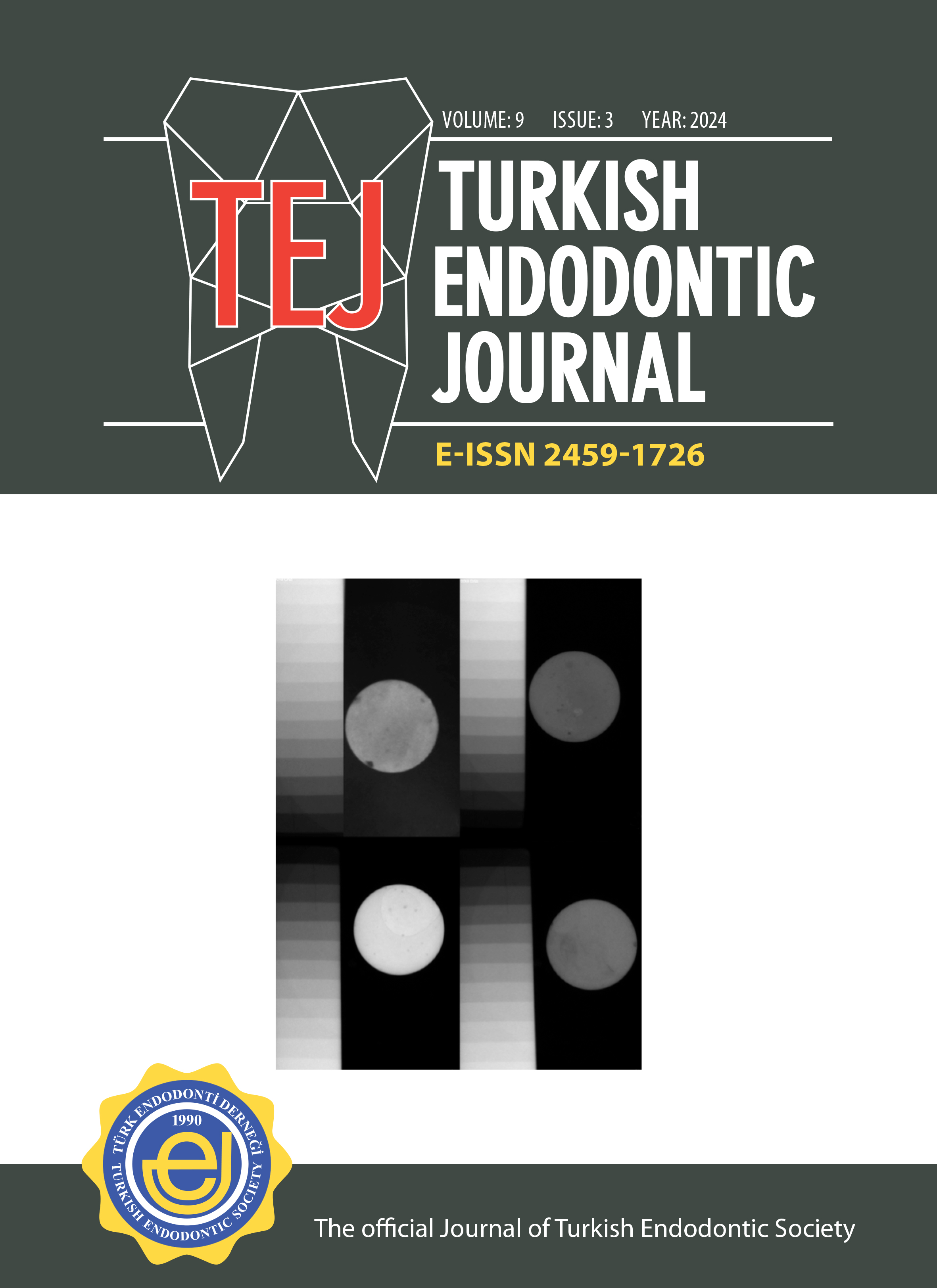Volume: 9 Issue: 3 - 2024
| 1. | Front Matter Pages I - VIII |
| ORIGINAL RESEARCH | |
| 2. | The effect of EDTA, phytic acid, and glycolic acid on dentinal tubule penetration of a bioceramic-based paste: A confocal study Elif Nur Yolcu, Sadullah Kaya doi: 10.14744/TEJ.2024.18480 Pages 119 - 124 Purpose: In this study, the effects of ethylene diamine tetraacetic acid (EDTA), phytic acid (IP6), and glycolic acid (GA) on the dentin tubule penetration of bioceramic-based sealers were evaluated by confocal laser scanning microscopy (CLSM). Methods: A total of 60 human mandibular premolar teeth were included. The teeth were divided into four groups (n = 15): Group 1: 5.25% NaOCl + 17% EDTA, Group 2: 5.25% NaOCl + 1% IP6, Group 3: 5.25% NaOCl + 10% GA, and Group 4: 5.25% NaOCl + distilled water (DW). The canals were filled with Bioserra canal paste mixed with 0.1% Rhodamine B. Results: The penetration depth and percentage of the bioceramic-based paste were significantly higher in all groups than in the control group. However, this difference was not significant for the penetration area. Conclusion: GA and IP6 are similar to EDTA in terms of their effects on bioceramic paste penetration. |
| 3. | Comparison of the radiopacity of NeoSealer Flo, Sure-Seal Root, Guttaflow Bioseal, and AH Plus Jet: An in vitro study Tugba Kosar, Davut Celik, Sinem Esen Mutlu, Tamer Tasdemir doi: 10.14744/TEJ.2024.30306 Pages 125 - 131 Purpose: To compare the radiopacity of two calcium silicate-based sealers (NeoSealer Flo and Sure-Seal Root), a calcium silicate particle-containing silicone (GuttaFlow Bioseal), and an epoxy resin-based root canal sealer (AH Plus Jet) using digital radiography. Methods: Five samples (1 ± 0.1 mm height, 10 ± 0.1 mm diameter) were prepared for each material tested. After the samples were completely set, digital radiographs of the samples and an aluminum stepwedge were taken. The mean gray values of each sample and aluminum step were calculated using the ImageJ program, and the values were converted into equivalent aluminum thicknesses. Kruskal-Wallis and post-hoc Dunn tests were used to analyze the data. Results: The radiopacity values of NeoSealer Flo (4.9 mm Al), GuttaFlow Bioseal (4.84 mm Al), and Sure-Seal Root (4.36 mm Al) were significantly lower than those of AH Plus Jet (10.83 mm Al) (p < 0.0001), but there were no significant differences among the three (p > 0.05). Conclusion: Although the calcium silicate-based and calcium silicate particle-containing siliconebased sealers exhibited lower radiopacity than the resin-based sealer, the radiopacity values of all root canal sealers tested met the minimum Al standard values advised by the International Organization for Standardization and the American National Standards Institute/American Dental Association. |
| 4. | The implication of social media on dentists concerning clinical performance and self-satisfaction for endodontic practice: A questionnaire-based study Burcu Deniz Şahin, Olcay Özdemir, Sibel Koçak, Duygu Aksoy, Gediz Geduk doi: 10.14744/TEJ.2024.36744 Pages 132 - 142 Purpose: To determine the role and impact of Instagram concerning use and sharing routines, its impact on the degree of self-satisfaction with post-treatment work, and its emotional influence on those performing endodontic treatment in clinical practice during simultaneous social media monitoring. Methods: The study was conducted using a questionnaire data collection method. The questionnaire, consisting of two parts—demographics with four questions and an assessment of the aim of the study with seven questions—was administered to 151 individuals (students, general dentists, and endodontists). Results: As a result of the analysis, 98% of the respondents use Instagram, 90.1% follow endodontic posts and videos, and 88.7% found that the information they accessed affects their clinical life. It was found that Instagram affects clinicians’ self-satisfaction (81.5%) in a good or bad way concerning their practice. A higher number of clinicians responded that they try to offer better work due to the impact of social media (68.3%). Conclusion: In light of the present findings, Instagram may be a source of data and motivation to improve clinical experience and skills when used appropriately. |
| 5. | Effect of different irrigation systems and gravity on the amount of apically extruded debris Hatice Harorlı, Esen Ercan, Melis Değermenci, Şeyma Nur Pektaş, Kürşat Er doi: 10.14744/TEJ.2024.47450 Pages 143 - 148 Purpose: This study evaluated the impact of different irrigation systems and gravity on debris extrusion during endodontic procedures. Methods: Sixty extracted human maxillary and mandibular canines meeting specific criteria were divided into groups: Group 1 comprised maxillary canines (n = 30), and Group 2 included mandibular canines (n = 30). Within each group, teeth were further subgrouped based on selected irrigation systems: a) Conventional Needle Irrigation (CNI) (n = 15), and b) Sonic Irrigation (SI) with EDDY (n = 15). Debris extrusion was measured. A two-way ANOVA was performed to assess the effect of irrigation systems and gravity on the amount of extruded debris. Results: The results indicated measurable apical extrusions of debris. Although the mandibular position caused more debris extrusion compared to the maxillary position, there was no significant difference related to the effect of gravity. Furthermore, within each group, SI with EDDY exhibited slightly more debris extrusion than CNI, but this difference was not statistically significant. Conclusion: These findings indicate that both the position (mandible and maxilla) and activation effects, either independently or interactively, do not create a statistically significant difference in debris extrusion. |
| 6. | Trends in endodontics research in leading dental vs. endodontic journals: Bibliometric analysis of 2019–2023 Nevran Derinler, Emel Uzunoglu Ozyurek, Mehmet Özgür Uyanık doi: 10.14744/TEJ.2024.58561 Pages 149 - 164 Knowing the endodontic research trends in Q1 dental journals can guide researchers during the sub-mission process. Therefore, this study aimed to evaluate endodontic research trends in Q1 dental journals over the last five years. The manuscripts published in these journals were retrieved using the Web of Science database. The VOS viewer software was used to analyze the saved articles. Only 4.3% (574 of 13,245) of articles published in Q1 dental journals were endodontics-related. The percentage of studies conducted with the cooperation of various dental and medical specialties was 73.5%. The majority of published articles were about devices and materials. Studies on regenerative endodontics, vital pulp therapy, and artificial intelligence were published in both journal groups. There is little research on post-endodontic restorations in endodontic journals compared to Q1 dental journals. The most frequently used keywords were “endodontics” and “dental pulp stem cell” in endodontic and other Q1 journals. In vitro studies were the most frequent study type (44.4%), followed by clinical studies (20.2%). Only 0.5% of articles were cited 100 or more times in both journal groups. Publication rates of endodontic articles are quite low in other Q1 journals. Conducting studies on topics that are more likely to be published may increase the acceptance rate of research. |
| 7. | Publication rates of endodontics specialization theses defended between 2015 and 2022: A bibliometric analysis Esra Balkanlıoğlu doi: 10.14744/TEJ.2024.62533 Pages 165 - 172 Purpose: Theses in dentistry that focus on specialized areas play a significant role in academic education. This study aims to examine the theses written in the field of endodontics and investigate the parameters related to their publication rates, shedding light on both the consultants who supervise these theses and the students who take part in the thesis preparation process. Methods: Theses defended between 2015 and 2022 were evaluated. The dates of submission of the theses, types of research, titles of the supervisor faculty members, subjects, and publication status of the theses were evaluated using PubMed, Google Scholar, and Dergi Park. Chi-square statistical analysis was performed. Results: Out of 434 specialty theses, 53 (12.21%) were published in national journals and 83 (19.12%) in international journals, totaling 31.33%. Of the 434 theses, 68 (15.66%) were published in SCI-E/ESCI indexed journals, 48 (11.05%) in TR indexed journals, 4 (0.92%) in other national journals, and 10 (2.3%) in other internationally indexed journals. Conclusion: In order to increase the rate of theses turned into scientific articles, advisors of theses should encourage their research assistants to publish their work. |
| 8. | In vitro evaluation of the bond strength of an epoxy resin-based and bioceramic root canal sealers after using different final irrigant agitation techniques Salih Düzgün, Hüseyin Sinan Topçuoğlu, İpek Eraslan Akyüz, İlke Manolya Özdemir doi: 10.14744/TEJ.2024.96658 Pages 173 - 180 Purpose: Evaluating the effect of different final irrigation agitation techniques on the bond strength of AH Plus Bioceramic sealer (AHPBS). Methods: Ninety single-rooted teeth were included in this study. Endodontic access cavities were prepared. The working length (WL) was established. All root canals were enlarged up to Protaper Universal F3. The teeth were then randomly divided into three main groups of 30 teeth according to the final irrigation agitation methods (n = 30). Group 1: Manual dynamic activation (MDA), Group 2: Ultrasonic irrigant agitation (UIA), Group 3: Sonic agitation (SA). The canals were dried using paper points before being obturated. Each group was randomly divided into three subgroups according to the type of root canal sealer (n = 10): AH Plus Jet (AHPJ), AHPBS, and Sure Seal Root (SSR). Push-out bond strength (PBS) tests were performed for all specimens. After the measurement of PBS, the failure types were evaluated with a stereomicroscope (BX60; Olympus, Tokyo, Japan) at 30× magnification. The failure types were classified as adhesive failure, cohesive failure, and mixed failure. Results: While AHPJ had the highest mean PBS value, SSR had the lowest mean PBS value (AHPJ > AH-PBS > SSR, P < 0.05). Coronal and middle thirds were statistically significantly lower than the apical third (P < 0.05), while they had similar mean PBS values (P > 0.05). UIA had a statistically significantly higher mean PBS value compared to MDA (P < 0.05). When failure types were evaluated, cohesive failure was the most frequent type of failure in all groups. Conclusion: All root canal sealers had the highest PBS value at the apical third, and an epoxy resin-based sealer also had a higher PBS value than a bioceramic-based sealer. The PBS value of all sealers may increase with UIA compared to MDA. |


















